华南农业大学:《农业生态学》课程教学课件(讲稿)Chapter 5 Population Regulation

Chapter 5 Population regulation
1 Chapter 5 Population Regulation
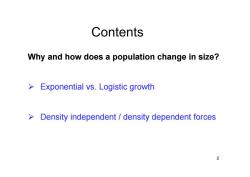
Contents Why and how does a population change in size? Exponential vs.Logistic growth >Density independent density dependent forces 2
2 Why and how does a population change in size? ¾ Exponential vs. Logistic growth ¾ Density independent / density dependent forces Contents
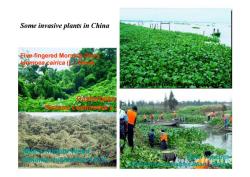
Some invasive plants in China Eive-fingered Morn oomoea cairica Castooav SiescestntE pes.(Mart
3 Five-fingered Morning Glory Ipomoea cairica (L.) Sweet Water Hyacinth Eichhornia crassipes (Mart.) Solms Castorbean Ricinus communis L. Mile-a-minute Weed Mikania micrantha H.B.K. Some invasive plants in China Water hyacinth (Eichhornia crassipes)
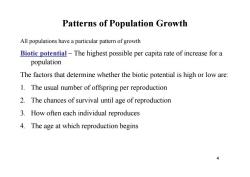
Patterns of Population Growth All populations have a particular pattern of growth Biotic potential-The highest possible per capita rate of increase for a population The factors that determine whether the biotic potential is high or low are: 1.The usual number of offspring per reproduction 2.The chances of survival until age of reproduction 3.How often each individual reproduces 4.The age at which reproduction begins 4
4 Patterns of Population Growth All populations have a particular pattern of growth Biotic potential – The highest possible per capita rate of increase for a population The factors that determine whether the biotic potential is high or low are: 1. The usual number of offspring per reproduction 2. The chances of survival until age of reproduction 3. How often each individual reproduces 4. The age at which reproduction begins
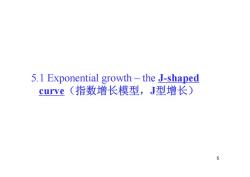
5.1 Exponential growth-the J-shaped curve(指数增长模型,J型增长)
5 5.1 Exponential growth – the J-shaped curve(指数增长模型, J型增长)

Exponential growth-the J-shaped curve (指数增长模型,J型增长) Exponential growth formula(公式) ·Nt=Noet where r is the exponential growth parameter (自然增长率) No is the starting population ·t is the time elapsed r is the maximum rate of increase of the population内禀增长率 r=0 if the population is constant, r>0 if population is increasing, 6 r<0 if the population is decreasing
6 Exponential growth formula(公式): • N t =N 0 ert • where r is the exponential growth parameter (自然增长率 ) • N 0 is the starting population • t is the time elapsed • r is the maximum rate of increase of the population 内禀增长率 • r=0 if the population is constant, r>0 if population is increasing, r<0 if the population is decreasing. Exponential growth – the J-shaped curve (指数增长模型, J型增长)
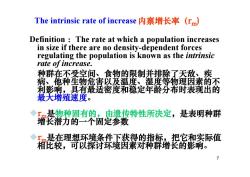
The intrinsic rate of increase内禀增长率(rm Definition The rate at which a population increases in size if there are no density-dependent forces regulating the population is known as the intrinsic rate of increase. 种群在不受空间、食物的限制并排除了天敌、疾 病、他种生物危害以及温度、湿度等物理因素的不 利影响,具有最适密度和稳定年龄分布时表现出的 最大增殖速度。 I是物种固有的,由遗传特性所决定,是表明种群 谓袋潜力的一个固定参数 ◆I是在理想环境条件下获得的指标,把它和实际值 相比较,可以探讨环境因素对种群增长的影响。 7
7 Definition :The rate at which a population increases in size if there are no density-dependent forces regulating the population is known as the intrinsic rate of increase. 种群在不受空间、食物的限制并排除了天敌、疾 病、他种生物危害以及温度、湿度等物理因素的不 利影响,具有最适密度和稳定年龄分布时表现出的 最大增殖速度。 rm是物种固有的,由遗传特性所决定,是表明种群 增长潜力的一个固定参数 rm是在理想环境条件下获得的指标,把它和实际值 相比较,可以探讨环境因素对种群增长的影响。 The intrinsic rate of increase 内禀增长率(rm)

The J-shaped curve has The LGraw-Hill Companies,Inc.Permission required tor reproduction two phases: Patterns of population growth Lag phase停滞阶段 growth is slow due to small population size exponential- growth Exponential growth phase指数增长期- -growth is 6 accelerating the population is exhibiting its biotic lag potential Time之
8 The J-shaped curve has two phases: • Lag phase停滞阶段 ––– growth is slow due to small population size • Exponential growth phase 指数增长期 – ––growth is accelerating & the population is exhibiting its biotic potential
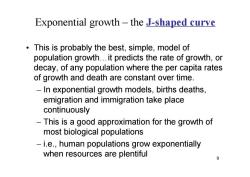
Exponential growth-the J-shaped curve This is probably the best,simple,model of population growth.it predicts the rate of growth,or decay,of any population where the per capita rates of growth and death are constant over time. In exponential growth models,births deaths, emigration and immigration take place continuously This is a good approximation for the growth of most biological populations -i.e.,human populations grow exponentially when resources are plentiful 9
9 Exponential growth – the J-shaped curve • This is probably the best, simple, model of population growth .it predicts the rate of growth, or decay, of any population where the per capita rates of growth and death are constant over time. – In exponential growth models, births deaths, emigration and immigration take place continuously – This is a good approximation for the growth of most biological populations – i.e., human populations grow exponentially when resources are plentiful
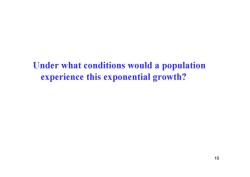
Under what conditions would a population experience this exponential growth? 10
10 Under what conditions would a population experience this exponential growth?
按次数下载不扣除下载券;
注册用户24小时内重复下载只扣除一次;
顺序:VIP每日次数-->可用次数-->下载券;
- 华南农业大学:《农业生态学》课程教学课件(讲稿)Chapter 3 个体生态学 Autecology.pdf
- 华南农业大学:《农业生态学》课程教学课件(讲稿)Chapter 1 Introduction Of Agricultural Ecology(2/2).pdf
- 华南农业大学:《农业生态学》课程教学课件(讲稿)Chapter 1 Introduction Of Agricultural Ecology(1/2).pdf
- 华南农业大学:《农业生态学》课程实验指导(打印版)种群和群落生态学实验、农业生态系统的能量测定、农业生态系统的物流测定和结构分析.pdf
- 华南农业大学:《农业生态学》课程授课教案 Teaching Plan for Agricultural Ecology(负责人:曾任森,打印版).pdf
- 山东农业大学:《农业生态学》课程教学大纲 Agroecology(Bilingual Teaching).doc
- 华南农业大学:《作物栽培学》课程教学资源(实验指导)实验五 水稻产量构成因素调查及产量预测.pdf
- 华南农业大学:《作物栽培学》课程教学资源(实验指导)实验二 水稻分蘖特性观察.pdf
- 华南农业大学:《作物栽培学》课程教学资源(实验指导)实验一 水稻秧苗素质调查.pdf
- 华南农业大学:《作物栽培学》课程授课教案Ⅱ(任课老师:唐湘如).pdf
- 华南农业大学:《作物栽培学》课程教学大纲 Crop Cultivation Science Ⅰ.pdf
- 华南农业大学:《农药残留分析》课程教学资源(教案讲义)第八章 核磁共振、第九章 滴定分析法.doc
- 华南农业大学:《农药残留分析》课程教学资源(教案讲义)第六章 可见紫外分光光度法、第七章 红外光谱法.doc
- 华南农业大学:《农药残留分析》课程教学资源(教案讲义)第五章 高效液相色谱法.doc
- 华南农业大学:《农药残留分析》课程教学资源(教案讲义)第四章 气相色谱法.doc
- 华南农业大学:《农药残留分析》课程教学资源(教案讲义)第一章 绪论、第二章 色谱法、第三章 薄层色谱法.doc
- 华南农业大学:《农药残留分析》课程教学资源(PPT课件)第五章 高效液相色谱法(1/2).ppt
- 华南农业大学:《农药残留分析》课程教学资源(PPT课件)第五章 高效液相色谱法(2/2).ppt
- 华南农业大学:《农药残留分析》课程教学资源(PPT课件)第十一章 农药残留分析概述.ppt
- 华南农业大学:《农药残留分析》课程教学资源(PPT课件)第十二章 农药残留样品的采集.ppt
- 华南农业大学:《农业生态学》课程教学课件(讲稿)Chapter 2 The Individual.pdf
- 华南农业大学:《农业生态学》课程教学课件(讲稿)Chapter 4 种群动态 Population Dynamics.pdf
- 华南农业大学:《农业生态学》课程教学课件(讲稿)Chapter 9 Environments.pdf
- 华南农业大学:《农业生态学》课程教学课件(讲稿)Chapter 11 & 12 Trophic Levels & Energy Transfer.pdf
- 华南农业大学:《农业生态学》课程教学课件(讲稿)Chapter 10 Habitat, Niches and population interactions.pdf
- 华南农业大学:《农业生态学》课程教学课件(讲稿)Chapter 13 Nutrient Cycling and Pollution.pdf
- 华南农业大学:《农业生态学》课程教学课件(讲稿)Chapter 14 群落生态学 Community Ecology.pdf
- 华南农业大学:《农业生态学》课程教学课件(讲稿)Chapter 16 群落演替 community succession.pdf
- 华南农业大学:《农业生态学》课程教学课件(讲稿)Chapter 20 & 21 Biodiversity & Conservation 生物多样性及其保护.pdf
- 华南农业大学:《农业生态学》课程教学课件(讲稿)Chapter 15 生态系统 Ecosystems、Chapter 17 世界生物群落类型 Biomes.pdf
- 华南农业大学:《农业生态学》课程教学课件(讲稿)Chapter 22 生态农业 Eco-agriculture.pdf
- 华南农业大学:《果树栽培学》课程教学资源(实验指导)果树系——《荔枝控梢促花研究》指导书及大纲.doc
- 华南农业大学:《果树栽培学》课程教学资源(实验指导)果树系——修剪程度对果树生长的影响.doc
- 华南农业大学:《果树栽培学》课程教学资源(实验指导)果树系——技条环剥处理对果树生物学与生理学效应研究.doc
- 华南农业大学:《果树栽培学》课程教学资源(实验指导)果树系——指导书参考格式.doc
- 华南农业大学:《果树栽培学》课程教学资源(实验指导)果树系——杨桃套袋对产量及果实品质的影响.doc
- 华南农业大学:《果树栽培学》课程教学资源(实验指导)果树系——果树的嫁接繁殖.doc
- 华南农业大学:《果树栽培学》课程教学资源(实验指导)果树系——果树花芽分化观察实验指导.doc
- 华南农业大学:《果树栽培学》课程教学资源(实验指导)果树系——疏果处理对果树生物学与生理学效应研究实验指导.doc
- 华南农业大学:《果树栽培学》课程教学资源(实验指导)果树系——疏果对果实生长发育的影响.doc
